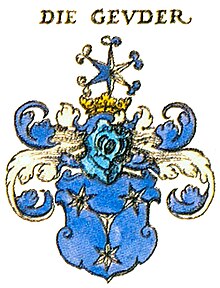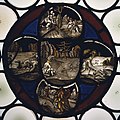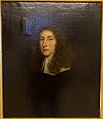Geuder von Heroldsberg
The Geuder von Heroldsberg were one of the oldest patrician families in the imperial city of Nuremberg , first mentioned in a document in 1253. The family seat that gave them their name was the Heroldsberg imperial fief, acquired between 1387 and 1391 . The Geuders were represented in the "Inner Council" from 1349, with brief interruptions, until the end of the imperial city period in 1806 and, according to the " Dance Statute ", belonged to the twenty old genders eligible for advice.
history
The Geuders probably came to Franconia from Bohemia and are said to have settled first in Kammerstein near Schwabach . The Geuders later moved to Nuremberg, where they can be traced back to 1303. They acquired Nuremberg citizenship and quickly became one of the most respected families of the Nuremberg patriciate . They belonged to the “Inner Council” of the free imperial city for around half a millennium and temporarily held the most influential offices there, such as that of the imperial schoolmaster and the high office of the foremost slogan . The Geuder increased their wealth, among other things, through long-distance trade . They traded spices and cloths to Cologne in the 14th century . They were found in Venice in the late 14th century and in Frankfurt am Main and Flanders in the early 15th century . Around 1418 they were doing financial business in Paris . You were also involved in mining companies.



In 1391 Konrad and Heinrich Geuder acquired the Reichslehen Heroldsberg , where descendants of the family are still based today. In 1417 the Geuder obtained a coat of arms from King Sigismund , which is now the coat of arms of the Heroldsberg market. 1471 awarded Emperor Friedrich III. the Geuders their own coat of arms. In Heroldsberg the Geuder obtained all the powers of the imperial knighthood , to which the "Fraisch", d. H. the high jurisdiction belonged. There they built the Green Castle on the site of the older castle as well as the White Castle in 1471 , the Red Castle in 1489 and the Yellow Castle in 1580 . The building owner of the Red Castle was the councilor and Reichsschultheiß Martin Geuder (1455–1532), a friend of Albrecht Dürer's , who made the drawing “Das Kirchdorf” during a visit to Heroldsberg in 1510 , the oldest pictorial representation of the place with the new building in the foreground can be seen (see figure below) . The Geuder expanded their property through clever trade and marriage policies and subsequent inheritance. For example, in 1440 they initially acquired a share in Neunhof bei Lauf and in 1445 the entire town as well as the town of Emskirchen through marriage and in 1501 the town of Stein , which remained in the family's possession for over 300 years.
They were also successful as civil servants and officers in imperial and princely services since the 16th century. In the Middle Ages they fought "infidels" on crusades and marched as military leaders against the Hussites . In later centuries they fought as officers in the Turkish Wars . You were in Dutch service and served the Swedish King Gustav Adolf and Frederick the Great . At all times they occupied leading positions in the ruling council of their hometown Nuremberg and were active in some embassies of the "Republic of Nuremberg", with the increasing spread of the family also as princely secret councilors in the service of Brandenburg , Nassau , the Electoral Palatinate and Anhalt .
Towards the end of the 16th century, the previous trade flows from the Levant , via Italy and the Alps to the southern German imperial cities, shifted to the north. The precious metals from America led to a money and sales crisis. Spain, France and the Netherlands declared bankruptcy several times . The Welsers , from whom the related Geuder had taken out loans, also ran into difficulties; their Augsburg trading company was insolvent in 1614, and the Welser branch in Nuremberg was sold in 1610. Since the beginning of the Thirty Years War in 1618, the Geuder got increasingly in financial difficulties. When they were also insolvent, the matter came before the Reichshofrat in Vienna, where it had been pending for decades. In the so-called "Laufer Settlement" in 1660, the Welsers were compensated for their outstanding loans through possession of the Geuder. The Welser received the entire Geuder share in Neunhof near Lauf, Beerbach , Tauchersreuth with all rights, the Geuder goods in Groß- and Kleingeschaidt, Simonshofen, Dehnberg, Pettensiedel and Letten as well as the ponds in Simonshofen and Laipersdorf.
In 1612 the Geuder gave up their Nuremberg citizenship and split into two lines in the 17th century: The Geuder-Rabensteiner (after the name and coat of arms association with the Rabensteiner zu Döhlau, who died in 1643 ) at the Green Castle in Heroldsberg became members of the imperial knighthood in the Franconian knight circle and carried an additional coat of arms. The Nuremberg Line took on Nuremberg citizenship again in 1662 and continued the tradition of working for the imperial city of Nuremberg as councilors, foremost slogans and imperial schools, custodians and custodians of imperial regalia as well as knight " De la Générosité " .
In the Holy Roman Empire the Geuder were imperial knights , in the Nuremberg patriciate since 1689 they carried the predicate "high noble born". With the fall of the Old Kingdom, the Geuders gradually lost their imperial knighthood and jurisdiction; In 1810 they had to hand over high jurisdiction to the Kingdom of Bavaria . Until 1848 they were limited to the lower jurisdiction by a patrimonial 2nd class. In 1813 the Geuder von Heroldsberg were enrolled in the class of knights of the Bavarian nobility and in 1822 they were raised to the baron class.
Both lines of the Geuder are extinct today in Germany in the male line. For this reason, the Bavarian State Ministry of the Interior appointed Dr. Roland Brunel, grandson of a Geuder von Heroldsberg, approved the use of the name Brunel-Geuder (without von ). Name bearers still live in the United States as descendants of Adolph Freiherr von Geuder von Heroldsberg, who emigrated to America in 1848.
Of the four Geuder castles in Heroldsberg, the White Castle was sold in 1928 and the Yellow Castle in 1957 ; the green or Rabensteiner Schloss (Kirchenweg 8) was inhabited by the Rabensteiner line until it died out in 1963 and sold in 1977; The Red Castle is now owned by the Geuder descendants Brunel-Geuder.
Possessions
- since 1487 the red castle in Heroldsberg (upper market)
Former possessions (extract)
The Geuder had large estates in Nuremberg and the Nuremberg area:
-
since 1387 the Reichslehen Heroldsberg :
 Heroldsberg 1708
Heroldsberg 1708- 1392–1977 the Green (or Rabensteiner) Castle in Heroldsberg (Kirchenweg 8)
- 1471–1928 the White Castle in Heroldsberg (Kirchenweg 4)
- 1489 – today the Red Castle in Heroldsberg (Upper Market)
- 1580–1957 the Yellow Castle in Heroldsberg (Hans-Sachs-Straße 2)
- 1391–1661 Großgeschaidt and Kleingeschaidt (built the manor there in 1614)
- 1391–1580 the manor house Grolandscher or Alter Sitz , Schwaiger Strasse 18–26, Behringersdorf
- 1441–1661 castles and the Neunhof manor (sold to the Welser people , who still own them today)
- 1570–1632 the manor Geuderschloss in Neunhof
- 1476–1634 the manor “Steinhaus” (Fürther Straße 47–49) in Bruck (Erlangen) (built in 1476 by Geuders 'officials and later loaned to inheritance lawyers, destroyed in the Thirty Years' War around 1632/34)
- ???? - 1801 the official seat "Keltschenschloss" (Fürther Straße 53) in Bruck, both on old Heroldsberg feudal farms
- 1501–1848 the Reichslehen Stein (1501–1717 Geudersitz Stein, demolished in 1922 for the new Faber-Castell factory buildings)
- 1539–1566 the Heuchling manor (Lauf an der Pegnitz)
- 1572–1616 the castle and the manor of Großgründlach (later: Hallerschloss)
- 1603–1658 the "Kleine Schlößchen" (Tolstoistraße 5–9) in Fischbach (broken off in 1938)
- 1615 - ???? the Herzogau glassworks
- 1720–1794 the Weiherhaus mansion
Kleingeschaidt manor
Old seat of Behringersdorf
Manor hypocrite
Weiherhaus mansion
coat of arms
Blazon : In blue an overturned silver triangle, each tip with a silver star.
The coat of arms of the Geuder-Rabensteiners is quartered with the coat of arms of the Rabensteiner zu Döhlau, who died in 1643 .
Scheurl / Geuder coat of arms , Nuremberg Lorenz Church
Coat of arms disk with tournament scenes, today in the Walters Art Museum
From Martin III. Disk commissioned around 1518 with hunting scenes by Veit Hirschvogel , Walters Art Museum
Schembart runner with the coat of arms of city governors Sebald Geuder and Leonhard Tetzel (around 1600)
Known family members


- Heinrich Geuder († 1389), patrician and councilor, Reichsschultheiß of Nuremberg from 1366 to 1385
- Endres Geuder (1431–1496), councilor, negotiator for Nuremberg on important political occasions. Imperial commissioner for the restoration of order in the broken imperial city of Weißenburg.
- Martin Geuder III. (1455–1532), patrician, Reichsschultheiß of Nuremberg, councilor, Losunger , from 1518 caretaker of all male monasteries in Nuremberg, from 1524 caretaker of the two Nuremberg parish churches, builder of the Red Castle in Heroldsberg (1489), friend of Albrecht Dürer .
- Jakob Geuder (1575–1616) gave up Nuremberg citizenship in 1612 and tried to introduce Calvinism in the Heroldsberg area. As a result, a dispute developed with the city of Nuremberg, which eventually led to a military conflict. He published Latin translations of Italian writings on the Turkish question, which appeared in Pietro Bizzarri's `` Rerum Persicarum Historia '' in Frankfurt in 1601, along with other texts, including Giosafat Barbaro's Persian reports.
- Johann Philipp Geuder von Heroldsberg called Rabensteiner zu Heroldsberg und Stein (1597–1650), high official in the imperial knighthood and with the counts of Löwenstein-Wertheim , captain in Swedish service, councilor in Anhalt and Brandenburg. Director of the entire imperial knighthood in Franconia, Swabia and on the Rhine. Founder of the so-called Geuder-Rabensteiner line.
- Johann Adam Georg Christoph Geuder von Heroldsberg (1641–1718), Reichsschultheiß of Nuremberg, Imperial Councilor
- Carl Benedikt Geuder von Heroldsberg (1670–1744), councilor, slogan and Reichsschultheiß, knight “de L'Ordre de la Générosité ” , custodian of the imperial regalia. He bought the Red Castle in Heroldsberg back from the Pfinzing family.
- Johann Adam Rudolph Carl Geuder von Heroldsberg (1718–1789), real imperial councilor, crown guardian and custodian of imperial regalia, knight council for the free knighthood of Franconia, privy councilor of Nuremberg, second slogan, chief curator of the monasteries of St. Clara and Pillenreuth and curator of the University of Altdorf .
- Adolph Freiherr von Geuder von Heroldsberg (1827-1906), He studied law and philosophy and was involved in the 1848 events as a Heidelberg student . He emigrated to the United States, but returned later. His descendants still live in the USA. He is the founder of the cemetery area and the funeral hall of the Heroldsberg community.
Johann Philipp Geuder-Rabensteiner (1597–1650), director of the imperial knighthood in Franconia, Swabia and on the Rhine, founder of the Geuder-Rabensteiner line, painted by Justus Sustermans , approx. 1620
Johann Adam Geudern from and to Heroldsberg and Stein, curator of the Landauer Twelve Brothers Foundation (1694)
Carl Benedikt Geuder von Heroldsberg (1670–1744), emperor. Councilor, crown guardian and custodian of imperial regalia , with son Johann Adam Rudolph Carl (1718–1789)
literature
- Christoph von Imhoff (Hrsg.): Famous Nuremberg from nine centuries . Nuremberg: Hofmann, 1984, 425 pages, ISBN 3-87191-088-0 ; 2., erg. U. exp. Edition, 1989, 459 p .; New edition: Edelmann GmbH Buchhandlung, October 2000.
- Michael Diefenbacher : Geuder von Heroldsberg, patrician family . In: Michael Diefenbacher, Rudolf Endres (Hrsg.): Stadtlexikon Nürnberg . 2nd, improved edition. W. Tümmels Verlag, Nuremberg 2000, ISBN 3-921590-69-8 ( online ).
See also
- Heroldsberg
- Patriciate (Nuremberg)
- History of the city of Nuremberg
- Castles, palaces and mansions in the city of Nuremberg
- List of Frankish knight families
Web links
Individual evidence
- ↑ Glossary German-New High German ( Memento of the original dated December 31, 2013 in the Internet Archive ) Info: The archive link was inserted automatically and has not yet been checked. Please check the original and archive link according to the instructions and then remove this notice. , uni-hamburg.de. Retrieved December 30, 2013.
- ↑ Bernhard Peter, Gallery: Photos of beautiful old coats of arms No. 1503

















